This site is made possible by its sponsors.
Please visit them!
chado - Also called the "way of tea," chado is the set of traditions surrounding the Japanese tea ceremony — "cha no yu." In the 12th century, the archetype of drinking powdered tea came to Japan from China. In the 16th century, strongly influenced by Zen Buddhism, Sen no Rikyu originated what became known as chado. Its fundamental principles are harmony, respect, purity, and tranquility. A student of chado is called a "chajin." The house used in the tea ceremony is called a "chashitsu."
Also see sublime.
chaitya hall - An Indian shrine, especially a Buddhist prayer-hall having a votive stupa at one end.
(pr. CHI:T-yə)
Example:
This chaitya hall is inside one of the 29 caves cut into living rock at Ajanta, India, over a period of 800 years. A stupa sits at the back of the hall.
Also see cathedral, chandi, Hindu art, and mosque.
Chaldean art - See Mesopotamian art.
chalice - A cup or goblet, especially that used in the sacraments of Christian churches.
Examples:

Kingdom of Alwa (Sudan), Chalice, found at Khalil el-Kubra, but probably produced further north at Alwa's capital, Soba, during the medieval period (7th-14th centuries), terra cotta, British Museum, London.
Byzantium, Chalice of Emperor Romanus II (959-963), gold, pearls, precious stones and medallions with busts of hierarchs. Its Greek inscription reads "Drink ye all of it." See Byzantine art.

Germany, Lower Saxony, c. 1160/70, Communion
Chalice, ("Wilten Chalice"), silver partially gilt,
with niello, height
16.7 cm, Kunsthistoriches Museum, Venice. See Romanesque.
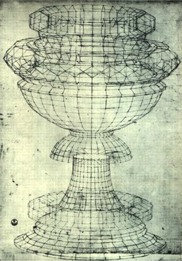
Paolo Uccello (born Paolo di Dono) (Italian,
1397-1475), Perspective
Study of a Chalice, pen
and ink on paper,
29 x 24.5 cm, Gabinetto dei Disegni, Uffizi, Florence. See linear perspective, Renaissance, and wireframe.
Russian, Greek Orthodox Chalice, 1898, gilded silver chalice is decorated with precious stones and eight medallions with enamel images of Christ, Hierarchs and Saints, Patriarchal Treasury, Greek Orthodox Archdiocese of America. The outer surface of the rim bears the inscription "Drink ye all of it; for this is my blood . . . . "
Also see vessel.
chamber of wonders - See Wunderkammer.
chamfer - To cut through the thickness of a material at an angle, giving a sloping edge. Also, an oblique face or bevel cut at the corner of a board or post. Or, to cut grooves or flutes into an edge, such as the furrows or grooves in a column.
champlevé - An engraved, etched, or otherwise grooved area on metal that is filled with enamel. Once fired, the enamel is polished down.
(pr. SHOM-plə-VAY)
Examples:
France, Conques (?), 1107-1119, Medallion Decorated with a Fabulous Animal, champlevé enamel on brass, diameter 8 cm, Louvre. See medallion and Romanesque.
Germany or Russia, around 1170, "Armilla": the Resurrection, Meuse, gilt brass, champlevé enamel, 0.113 x 0.147 m, Louvre. See jewelry.
Germanic Holy Roman Empire, Hildesheim, Lower-Saxony, around 1175, Reliquary of St. Henry, gilt brass, engraved, champlevé enamel and rock-crystal, silver on wood core, 0.236 x 0.161 m, Louvre. See reliquary.
France, Limoges, around 1220-1230, Arched Plaque Decorated with a Figure of St. Matthew, gilt brass, champlevé enamel, 0.29 x 0.14 m, Louvre. See plaque.
Also see cloisonné.
chance - See aleatory and aleatoric.
chancel - The part of a church reserved for clergy and containing the altar and the choir.
chandi - A Javanese temple.
Also see cathedral, chaitya hall, mosque, and stupa.
change - To make something become different. To give a different arrangement or direction to something. To substitute, alter, vary, modify, transition, or transform. To become different, as a design or picture might. To move away from sameness, monotony, exact repetition. The concept of change is linked with those of permanence and impermanence, metamorphosis, adaptation, evolution, innovation (newness), and modernism.
Cultural attitudes
to changes in society — political, religious, and other reforms
and revolutions occurring amid developments in the arts,
sciences, technology,
business, and other fields — are of either of two or more types,
including:![]()

![]()
Quotes about change:

Also see animation, aphorism, attitude, automata, carve, cast, choose, cinema, color, consistency, curve, drill, enlarge, Fluxus, four-dimensional, gradation, kinesiologist, kinetic, manipulate, mark, measure, mobile, movement, music, nuance, periodicity, posterity, reduce, science and art, space-time, time, tradition, transform, variation, various, and video.
chaos - Disorder or confusion. The opposite of order.
Quote:
Also see chiastic, coherence, composition, creativity, déjà vu, destruction, entropy, forget, and Rube Goldberg.
chapel - A small church, or an area or compartment in a church containing an altar dedicated to a particular saint. A prominent feature of many Romanesque churches is the addition of multiple "radiating" chapels. Churches during the Romanesque period were often in the relics business: the more relics they displayed, the more donations they received. Each of the chapels a church had would provide a site for each relic, often funded by a wealthy donor.
Examples:
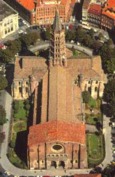

France, Toulouse, St. Sernin, c. 1080-1120,
Romanesque cathedral.
An
aerial
view photograph of St. Sernin from one angle (the tower is of 1250 with its spire of 1478 belongs
to the Gothic
period) and from another angle in which one can see the
exterior forms of the chapels.
A floor plan of St. Sernin showing the location,
shape and size of nine chapels.
![]()

![]()
A photo of the exterior of the apse, showing three of its
radiating chapels.
See aerial view, apse, axonometric projection, capital, chapel, nave, and plan.
chaplet - In lost-wax casting, a core pin or refractory spacing block connecting the core placed within a wax model to its surrounding mold. There are often many employed for each work, and may vary in size from thin wire to thick bars of metal, depending on the scale of the model. When the wax is melted from the mold, the chaplets keep the core from shifting. When molten metal is poured in, they are incorporated into it, and when the investment is broken off, they protrude from the surface of the metal. When they are made of the same alloy as the cast, they are difficult to find once they have been filed down. If they fall out when the core is removed, they leave holes which must be filled.
characters - Individual letters, numbers and other dingbats, glyphs, or symbols.
Also see align and alignment, calligraphy, capital letters, dingbat, font, graphic design, letterform, lettering, lowercase, text, and typography.
charcoal - Compressed burned wood used for drawing.
Examples of charcoal drawings:

Paul Gauguin (French, 1848-1903), Tahitians, c. 1891-93, (depicted Tahiti,
made France), charcoal on laid paper,
16 1/8 x 12 1/4 inches (41 x 31.1 cm), Metropolitan Museum of
Art, NY. See Post-Impressionism.
Henri Matisse (French, 1869-1954), Reclining Nude, 1938, charcoal on paper, 23 5/8 x 31 7/8 inches (60.5 x 81.3 cm), Museum of Modern Art, NY. See nude.

Arshile Gorky (American, 1905-1948), The Artist's Mother, 1938, charcoal on
paper, 63 x 48.5 cm, Art Institute
of Chicago, IL. See Abstract
Expressionism.
Related link:
Also see chalk, crayon, fusain, graphite, pastel, pencil, sketch, and study.
charette - In architecture, an intense effort to complete a design project within a specified time. Also spelled charrette, this French word refers to a handcart or barrow.
Also see argument, collaboration, critique, deadline, and discussion.
charm - Something worn or spoken for its supposed magical benefit — warding off evil or attracting good luck, perhaps.
Also see amulet, ex voto, fetish, milagro, and talisman.
charrette - An alternative spelling of charette.
chart - See diagram and graph.
chasing - The process of finishing and refining a metal surface of metal object 's surface by denting rather than engraving it with steel tools such as tracers, ciselet, punches, and matting tools. Chasing might be done in order to remove the imperfections and rough spots on a bronze cast which necessarily form in the casting process. Chasing might also be done in order to ornament metal surfaces by embossing or hollowing with tools.
chatra - See parasol.
 chess - A board game
for two players, each beginning with 16 pieces of six kinds — king, queen, castle, bishop, knight, pawn — that
are moved according to certain rules, with the objective of checkmating
(capturing) the opposing king — originally called the "shah."
The winner then announces that the king is "dead" (mat).
The term "checkmate" came from shah mat (perhaps
also sheikh mat). "Shah" evolved, through an
Old French plural, esches, into chess: also into checkers,
both the game and the design. The Exchequer, which in England
deals with the financial side of government, probably derived
from the checkerboard tables, eschequier, used in the Middle
Ages to facillitate counting. A bank check comes from the same
source. The game of chess seems to have entered Europe with the
Arabs, at the time of their conquest of Spain. They had learned
it from the Persians, who apparently found it in India.
chess - A board game
for two players, each beginning with 16 pieces of six kinds — king, queen, castle, bishop, knight, pawn — that
are moved according to certain rules, with the objective of checkmating
(capturing) the opposing king — originally called the "shah."
The winner then announces that the king is "dead" (mat).
The term "checkmate" came from shah mat (perhaps
also sheikh mat). "Shah" evolved, through an
Old French plural, esches, into chess: also into checkers,
both the game and the design. The Exchequer, which in England
deals with the financial side of government, probably derived
from the checkerboard tables, eschequier, used in the Middle
Ages to facillitate counting. A bank check comes from the same
source. The game of chess seems to have entered Europe with the
Arabs, at the time of their conquest of Spain. They had learned
it from the Persians, who apparently found it in India.
Chess images:
France, Paris, around 1300, Mirror Case: the Game of Chess, ivory, diameter 0.12 m, Louvre. See circle, Middle Ages, relief, and tondo.

Josef Hartwig (German, 1880-1955), manufactured by Bauhaus, Weimar, Chess Set, 1924, pear wood, natural and stained black, smallest: 7/8 x 7/8 x 7/8 inches (2.2 x 2.2 x 2.2 cm), largest: 1 7/8 x 1 1/8 x 1 1/8 inches (4.8 x 2.9 x 2.9 cm), Museum of Modern Art, NY. See wood.
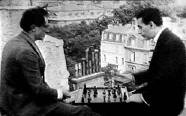
Photo
of Marcel Duchamp playing chess with Man Ray in Paris. See
Dada.
Quote:
Also see game theory.
chevet - The eastern end of a Gothic church, including choir, ambulatory, and radiating chapel.
(pr. shə-VAY)
Also see apse.
![]()

chevron - A zig-zag or V-shaped shape.
(pr. SHE-vron)
Examples of chevrons in works of art:

Kenneth Noland (American, 1924-), Shoot, 1964, acrylic
on canvas, 103 3/4 x 126 3/4
inches (263.5 x 321.9 cm), Smithsonian American Art Museum, Washington,
DC. See hard-edge.
Also see diagonal and heraldry.
chi or qi - See feng shui.
chiastic - Principally a literary formation, characterized by an inversion of the order of words in two otherwise corresponding parallel phrases, as in the example: "She gave to the poor, to the poor gave she."
(pr. ki:-ASS-tək)
Also see composition.
Chicano art and Chicana art - Generally refers to the culture of Mexican-Americans, and is part of Latino and Latina art. Use of these terms is problematic because while in some regions of the American Southwest they suggest ethnic pride, in others they may be felt to be derogatory. Alternative terms might include Latin American art, Hispanic art, and Hispanic-American art.
Examples:
![]()

Carlos Cortez (American, 1923-), De la tierra somos !no somos ilegales!,
1984, linoleum cut in black
on paper, 36 x 24 1/4 inches (91.5
x 61.6 cm), Smithsonian American Art Museum, Washington, DC.

Carlos Cortez, To Fan the Flames!, 1984, linoleum
cut in black on paper, 22 1/2
x 17 inches (57.1 x 43.2 cm), Smithsonian American Art Museum,
Washington, DC.
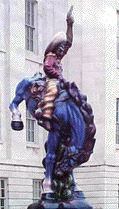
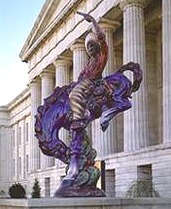
Luis Jiménez (American, born 1940
in El Paso, TX, died 2006 near Taos, NM), [2 views] Vaquero, modeled
1980, cast 1990, cast in
fiberglass and epoxy
resin, 16 1/2 feet high, National Museum of American Art,
Washington, D.C.

Luis Jiménez, Southwestern Pietà, 1983, 30 x
44 inches, lithograph,
collection of Gary D. Keller Cárdenas. The Hispanic Research
Center at Arizona State University offers further information about Luis Jiménez,
this artwork and its context, along with viewpoints for interpreting
it. See Pietà.

Yolanda López (American, 1942-), Portrait of the Artist as the Virgin of Guadalupe,
1978, oil pastel on paper,
32 x 24 inches, collection of the artist. See feminism and feminist art, flag, and mandorla.

Jesse Trevino (American, born Mexico, 1946-),
Mis Hermanos, 1976, painting, National
Museum of American Art, Washington, D.C. See Mexican
art.
![]()

Jesse Trevino, Tienda de Elizondo, 1993, painting, National
Museum of American Art, Washington, D.C.
Another resource:
Also see ethnic, Mesoamerican art, and Mexican art.
![]()
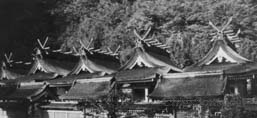
![]()
chigi - In Japanese architectural tradition, crossed beams extending upwards from both ends of the roof gables on a Shinto structure. Chigi originated in ancient times.
Also see diagonal and Japanese art.
chimneypiece - See mantlepiece.
chine collé - A technique in printmaking in which an impression is made on a surface at the same time as its opposite side is adhered to a heavier support in the procedure. This process permits printing onto such delicate materials as rice paper and linen, allowing the plate to produce finer details in the printed image than would normally be possible. Once an adhesive (traditionally a solution of rice flour and water) has been applied to the reverse side of the lighter material, the heavier support (typically, such a heavyweight paper as is typically used in printmaking) is placed upon it. In applying the pressure of the press, the reverse side of the lighter material adheres to the support as an image is simultaneously printed onto its obverse side.
(pr. sheen koh-LAY)
Example:

Rembrandt Peale (American, 1778-1860),
George Washington, 1827, lithograph on chine collé, Worcester
Art Museum, MA.
Chinese ink - See India ink.
Chinese white - See zinc white.
Ching - A Chinese dynasty (also called Qing and Manchu) which lasted 1644-1911.
Examples of works from this period:

Wang Hui (Chinese, 1632-1717),
Three
leaves from Landscapes and Flowers, 1672, ink
and color on
paper, National Palace Museum, Taipei.
See botanical and chop.
![]()
Dao
Ji (Shitao) (Chinese, 1642 - 1707 or 1708), Autumn Landscape, Ching dynasty, 1701,
hanging scroll; ink and color on paper,
signatures: Zing-Xiang chen ren, Dadizu, and Shitao; seals:
five of the artist, two of the collector Ouyang Lin dated 1907,
three of collectors in lower left, and four in the lower right
corner, Worcester Art Museum, MA.

China, Chuba, Ching dynasty
(1644-1911), 17th century, cut velvet with patterned wefts
of multicolored silks, gold-wrapped silk, and peacock-feather
filaments, width 55 inches (139.7 cm), Metropolitan Museum of
Art, NY. See costume.
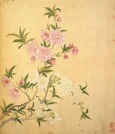
Yun
Bing (Chinese, active c. 1670-1710), Flowers, from an album of 12 leaves,
ink and colors
on silk, Asian Art Museum, San Francisco, CA. See botanical.

China, Emperor's 12-Symbol Robe, 18th century,
Ching dynasty, silk, metallic thread, 63 1/2 x 56 3/4 inches
(161.29 x 144.15 cm), Metropolitan Museum of Art, NY. The emblems reserved for the emperor's
ceremonial robes were the twelve imperial symbols
seen on this garment: sun, moon, constellation, mountain, pair
of dragons, bird, cups, water weed, millet, fire, ax, and the
symmetrical "fu" symbol.

China, Ching dynasty, mark and reign of the
Yongzheng emperor (1723-1735), Plate with Birthday Greeting, porcelain with underglaze blue and overglaze enamel decoration,
Asian Art Museum, San Francisco, CA.
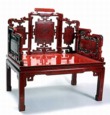
China, Ching dynasty, Throne, probably mid to late 1800s, lacquered wood,
Asian Art Museum, San Francisco, CA. See furniture.
Also see Chinese art.
chinoiserie - A French word also used by English speakers, for any aspect of Chinese influence on the arts and crafts of Europe, whether produced by Chinese artists, by Europeans, or by others. This term is generally reserved for objects made in the late 17th and throughout the 18th centuries. This roughly coincides with a massive increase in exports from China following the lifting of China's ban on foreign trade in 1684.
In every age following the return of the Italian Marco Polo from his 13th century journey to China, Europeans experienced waves of interest in Chinese culture, variously seen as exotic, mysterious, and beautiful. With eastern Asia's distance from Europe adding to the appeal of its exports, as well as to the expense of obtaining them, a market in objects evoking Chinese styles thrived. Even when their authenticity as truly Chinese was simulated, Europeans' interest resulted in the production of objects displaying various sorts of imitation, emulation, and speculation, with many Oriental crafts designed specifically for the European taste.
In London throughout the 1740s, there was a revival of the enthusiasm for chinoiserie, which had been prevalent in the late seventeenth century. Chinoiserie taste was expressed in Western imitations or evocations of Chinese art, which were seldom accurate and always rendered with some deference to the European stylistic ideals of the time. The most notable examples of 17th century chinoiserie include Dutch Delft ceramics, French embroidery, and "japanned" furniture made in the Netherlands and in England. On furniture coated with this lacquer substitute, chinoiserie presented numerous subjects from the Middle Kingdom: pagodas, white cranes, and small Oriental figures.
Particularly popular in the Rococo period was a type of chinoiserie reflecting fanciful and poetic notions of China. Such objects included textiles, porcelains, and architecture. Jean-Antoine Watteau (French, 1684-1721) and François Boucher (French, 1703-1770) were among the French Rococo painters of Chinese subjects. Thomas Chippendale, the chief exponent in England, produced a unique and decorative type of furniture. In the American colonies Chinese objects and wallpapers were employed in the decoration of rooms, most notably in Philadelphia.
Although the popularity of chinoiserie faded as interest in Neoclassicism increased in the second half of the 18th century, there was a revival in the early 19th century, as seen in the extravagant architecture and decoration of the Royal Pavilion at Brighton, England. By this time, however, the Chinese taste can be considered as part of the emerging cult of the picturesque.
Parallels to chinoiserie have become increasingly common in today's global culture, as members of nearly every society are drawn to consume products from across the world. Witness the popularity of Japanese animation, Jamaican reggae, American fast foods, television, movies, etc. This trend is furthered by viewing such materials as the pages you find here.
(pr. shə-NWAH-zə-REE)
Examples:

Amoy (English, 19th century), Chinoiserie Foot Bath, 19th century,
glazed ceramic,
8 1/2 x 19 x 13 7/16 inches, Minneapolis Institute of Arts.
Also see Chinese art, ethnic, multiculturalism, orientalism, world-view, and xenophilia.
chipping out - In lost-wax casting, using a blunt chisel to remove the investment.
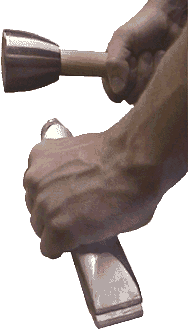
chisel - A cutting tool
consisting of a metal  shaft beveled
at one end to form the cutting edge.
A chisel is specially designed for cutting
shaft beveled
at one end to form the cutting edge.
A chisel is specially designed for cutting  a particular material
— wood, metal or stone.
a particular material
— wood, metal or stone.
Also see adze, chase, chipping out, ciseau, ciselet, drove, flat chisel, gouge, pick, pitcher, point, staple, and tooth.
chiton - A Greek tunic, the essential (and often only) garment of both men and women, the other being the himation or mantle; a kind of cape.
(pr. KI:-tən)
Examples:

Greece, Chios, c. 510 BCE,
Kore,
polychromed marble,
height 21 1/2 inches, Acropolis
Museum, Athens. This kore
wears a chiton. Many detales are intricately carved.
The right arm originally reached out, and may have held an offering.
Although marble statues were often painted in ancient Greece,
very few examples of polychromey
are as intact as this one. Another point of view on this kore.
![]()
Greece, Figure of a Warrior, late 6th century
BCE,
bronze, Worcester
Art Museum, MA.

Greek, South Italy, Agrigento, Red-Figure Pelike, c. 450-440 BCE,
terra cotta, Museo Archaeologico
Regionale, Palermo, Sicily. This pelike is a wine vessel
decorated with a scene from
the myth of Dionysos, god of wine. On the front of the vase,
the messenger god, Hermes, wearing a traveler's cloak, winged
hat and shoes, entrusts the baby Dionysos to Ino, who will become
his nurse. Here we see two chiton-wearing nymphs depicted on
the other side of the vase. See mythology
and pelike.
Also see chlamys, costume, fibula, Greek art, and peplos.
chlamys - A piece of ancient Greek costume, a short woolen cloak worn by men (and Amazons) and fastened on the right shoulder.
Also see himation, mantle, and peplos.
chlorophyll - Green pigment found in plants.
choir - The part of a church or cathedral where services are sung. It is usually east of the transept, and within the chancel, but may extend into the nave, and is often separated from the nave by a screen.
choose, choice - To choose is to select freely and after consideration; or to decide, form a preference, make a selection, or take an alternative. Choosing, along with ordering and expressing, is among the most fundamental activities of an artist. As a general rule, the more options one can compare and contrast, one's chances of selecting the most satisfactory option are increased.
A choice is an act of choosing, or the power to choose, or the person, place or thing chosen. Alternatively, "choice" is sometimes used as an adjective indicating high quality.
Quote:
Also see achievement, arrange, blocks to creativity, brainstorm, change, composition, creativity, design, different, knowledge, motivation, philately, plan, thematic, time, and visualize.choose


chop - An impression made by an artist's or another person's seal, traditionally used as a kind of signature in the Far East. These seals have usually been made in square, circular and oval shapes, their impression surfaces carved to produce either a red (positive) or white (negative) mark.
Examples:

Attributed to Han Gan (Chinese, active 742-756),
Night-Shining White, T'ang
dynasty, 8th century, ink on paper, 12 1/8 x 13 3/8 inches (30.8 x
34 cm), Metropolitan Museum of Art, NY. This is one of the most
revered horse paintings in Chinese
art. This short scroll
displays a formidable provenance
in the form of chops of its former owners. See equine
art.
Also see Chinese art and Japanese art.
chroma - Among colors other than those in the black-white scale, the specific combination of a color's hue, intensity, and saturation; or the degree of a color's vividness.
chroma key - Refers to a level of chroma from high to low intensity and saturation. A high chroma key is bright and pure. A low chroma key is dull and murky.
Also see color schemes, contrast key, temperature key, tonal key, and value key.
chromatic pigments - All the pigment which are neither black, white, nor gray — the achromatic pigments.
Also see chroma.
![]() chrome or chromium - A hard, brittle,
bluish-white metal used chiefly
in stainless steel and
for electroplating other metals.
Although chromium is an element, chrome can be either pure chromium
or an alloy of it. Chromium's
elemental symbol is Cr; atomic number 24; atomic weight 51.996;
melting point 1,890°C; specific gravity 7.18; valence 2, 3,
6.
chrome or chromium - A hard, brittle,
bluish-white metal used chiefly
in stainless steel and
for electroplating other metals.
Although chromium is an element, chrome can be either pure chromium
or an alloy of it. Chromium's
elemental symbol is Cr; atomic number 24; atomic weight 51.996;
melting point 1,890°C; specific gravity 7.18; valence 2, 3,
6.
Example:

Sven Wingquist, designer, manufacturer: SKF
Industries, Inc., USA, Self-Aligning Ball Bearing, 1929, chrome-plated steel, 1 3/4 x 8 1/2 inches (4.4 x 21.6
cm) diameter, Museum of Modern
Art, NY. MOMA's site says, "Good design was considered by
modernists as essential to the elevation of society, and in 1934,
this ball bearing was among the first works to enter The Museum
of Modern Art's design collection." See circle,
design, and
technology.

Richard Hunt (American, 1935-), Hero Construction, 1958, found steel, welded and chromed, height 175.3 cm, Art Institute of Chicago. See African American art.
chrome yellow - A particular yellow pigment.
Related resource:
chromolithography - A lithographic process using several stones or plates — one for each color, printed in register. The result is color prints, to be distinguished from colored prints that have the color hand-applied after printing.
Examples:
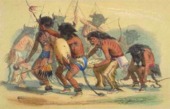
George Catlin (American, 1796-1872), The Buffalo Dance,
1848, chromolithograph, from a set of prints: "Die Indianier
Nord Amerikas", published in Brussels, Belgium. Such prints
were effectively reproductions
of paintings. See American Indian
art and dance.

Rebecca Coleman (American artist), Raphael
Tuck Company (publisher), A Glad New Year, Good Angels Guard Thee,
a chromolithographed greeting card for the 1881-2 holiday season.
This card's design was one of seven derived from a series of
seven angel paintings
by Coleman titled "Angel's Heads". The cards were very
popular. On each of the seven designs, Tuck added a different
message and verse. The verse on the back of this card:
I stand in the New Year light
And I look towards the Sun,
And I see through the aether bright
& fair, and Angelic one!
Tis Hope, tis the Morning Star! -
The angel of Days To Be!
To the gleam of its wings afar
turn, and I hope, for thee!
Eden Hooper


American, American Tobacco Company, Ty Cobb
Baseball Card, Detroit Tigers, 1911, chromolithograph
on recto, Library of Congress,
Washington, DC. Packaged as a giveaway with tobacco, chewing-gum,
and other products, such cards have always been collectible.
See ephemera and memorabilia.

James Montgomery Flagg (American, 1877-1960),
I Want You for U.S. Army, 1917, chromolithograph,
39 1/2 x 29 1/8 inches (100.4 x 73.8 cm), National Museum of
American Art. Flagg's version of Uncle Sam is a self-portrait. Used for recruitment
during World War I and again during World War II, his popular
poster demonstrates
the commanding effectiveness of a strong design
and simple message. See icon.
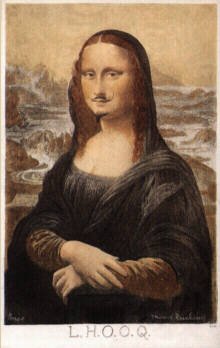
Marcel Duchamp (French-American, 1887-1968),
L.H.O.O.Q.,
1919, rectified readymade,
pencil on a reproduction
— a chromolithograph, 7 3/4 x 4 7/8 inches, private collection,
Paris. As if the addition of mustache and beard weren't enough
of a poke at this most famous of paintings, the letters Duchamp
penciled -- L.H.O.O.Q. — at the bottom of his altered image
are meaningless in themselves, but when read aloud in French,
make the sound of "Elle a chaud au cul," meaning, "She
has a hot ass." See aerial
perspective, anti-art,
landscape, Renaissance, sfumato,
text, and xenophobia.
chronology - The arrangement of events in the order in which they occured in time; sequential order. Or, a list, a survey, or exhibition which is sequenced in this way. Such linear narratives follow an easy logic, but can be oppressive. The most commonly employed alternative model is thematic.
Quote:
Also see abecedarian, composition, excavate, horology, periodicity, rhythm, shard, and taxonomy.
chuban - In Japanese art tradition, a size of paper, used for prints, measuring about 11 x 8 inches, sometimes smaller.
Also see oban.
https://inform.quest/_art